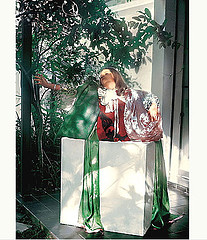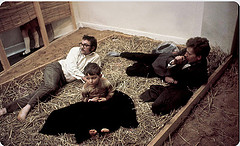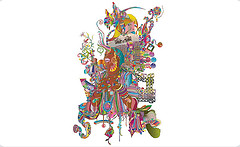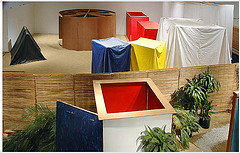Andrea takes the B train
Post by Andrea Kirsh
On last week’s trip to New York I took the B train to the Bronx Museum of the Arts, in its new Arquitectonica-designed space, to see the Tropicalia exhibition, curated by the PMA’s Carlos Basualdo. The show would be valuable for anyone who had not seen the Helio Oiticica exhibition at the New Museum in 2002 (also curated by Basualdo). Much of that work had been done when the artist was in exile in New York, and the exhibition was frank about the drugginess of the environment. My most vivid memory of it was leaving with my slacks (black, of course) covered with flour from wallowing around in one of Oiticica’s highly-interactive environments; he could hardly have known that black would be the art-world uniform forty years later, but I suspect his spirit was laughing at the joke.

Lygia Pape and Helio Oiticica, Courtesy of Projeto Lygia Pape, Photo by Mauricio Cirne. The Tropicalia exhibit was previously at the Barbicon Art Center, London from Feb 13-May 22. The Barbicon’s Tropicalia website multimedia page has clips of music by Caetano Veloso, Gilberto Gil, Os Mutantes, Tom Ze and Gal Costa. Highly recommended.
On the audio tour Carlos situated Tropicalia within the repression of Brazil’s military dictatorship and a period of exceptional interaction between high and low culture and among music, literature and the visual arts. Those who don’t know of artists Lygia Clark, Nelson Leirner or Lygia Pape are likely to recognize the sounds of Gilberto Gil and Caetano Veloso.

Hélio Oiticica, Eden, Whitechapel Art Gallery, London, 1969, Copyright © Projeto Hélio Oiticica (Rio de Janeiro, Brazil)
I entered by the ramp, literally walking on a hallucinogenic wallpaper/collage that covered most of the entry wall, then oozed down onto the floor. It was by the equally-colorfully-named artist, assume vivid astro focus, and was one of a number of works by current artists that enlivened the show, confirming the strength of Tropicalia’s tradition. The first large room included several monitors with historical footage, a range of posters and ephemera and an installation of women’s clothing in acid greens and orange that would be snapped up on South Street today. The fabrics were artist-designed, and ranged from alphabetic repeats to Surrealist-derived. The audio tour was essential here to fill in the political history.

assume vivid astro focus, Rita Sylvester, 2003, Courtesy of John Connelly Presents, New York, and Peres Projects, Los Angeles/Berlin
Oiticica considered participation to be Brazil’s major artistic contribution. This brings up the inherent problem of museum exhibitions such as this. The work is not only presented out of time and shorn of any real political implications, but the white cube of the exhibition space deracinates it. Despite exhibition copies of Lygia Clark’s masks and gloves (which visitors are encouraged to play with) and Oiticica’s eponymous installation, where, having left my shoes by the door, I walked through sand, narrowly avoided a puddle of water and talked to a couple of live parrots, the exhibition nevertheless gave a clean, dry and official version of an art movement that was wet, sticky, oppositional and occasionally illegal.

Helio Oiticica, Tropicalia, 1967, MCA Chicago installation shot. The exhibit was at the MCA Chicago from Oct. 22, 2005-Jan. 8, 2006.
I’m sure it made a difference that I was one of only six visitors on a Friday afternoon; the Family Day on October 29th will certainly be closer to the sociability and interaction that the artists intended.
As I left the museum, the sand in my socks from Oiticica’s installation provided a visceral reminder that art in the late 20th century and today is larger and messier than our museums can contain.
[Ed. note: Here’s my interview with Carlos Basualdo when he first arrived at the PMA.]
–Andrea Kirsh is an art historian living in Philadelphia. Read articles from her new Philadelphia Introductions series at Inliquid.









